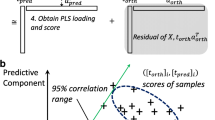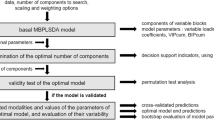Abstract
Metabolomics data are typically complex and high dimensional. Multivariate dimension-reducing techniques have thus been developed for analysing metabolomics data to disclose underlying relationships, with principal component analysis (PCA) as the technique mostly applied. Despite its widespread use in metabolomics, PCA has shortcomings that limit its applicability. Several approaches have been made to overcome these limitations and we describe an advanced disjoint PCA (DPCA) model, termed concurrent class analysis and abbreviated as CONCA. CONCA is a new model, and is unique in linking DPCA models to a traditional PCA model. This is accomplished by restructuring the input data matrix, applying DPCA group models to the restructured data, and combining the DPCA models in order to replicate a traditional PCA. We applied the CONCA model to a metabolomics data set on isovaleric acidaemia (IVA), a rare inherited metabolic disorder. The outcome showed that three of the variables with high discrimination value identified through the CONCA analysis are prominent organic acid biomarkers for IVA. Moreover, three further minor metabolites associated with the disease, and two as a consequence of treatment, were likewise identified as important discriminatory variables. The benefit of the CONCA model thus is its ability to disclose information concerning each individual group and to identify the variables important in discrimination (VIDs) which are also responsible for group separation.


Similar content being viewed by others
References
Bicciato, S., Luchini, A., & Di Bello, C. (2003). PCA disjoint models for multiclass cancer analysis using gene expression data. Bioinformatics 19, 571–578.
Bijlsma, S., Bobeldijk, I., Verheij, E., Ramaker, R., Kochhar, S., Macdonald, I., van Ommen, B., & Smilde, A. (2006). Large-scale human metabolomics studies: A strategy for data (pre-) processing and validation. Analytical Chemistry 78, 567–574.
Boulat, O., Gradwohl, M., Matos, V., Guignard, J., & Bachmann, C. (2003). Organic acids in the second morning urine in healthy Swiss paediatric population. Clinical Chemistry and Laboratory Medicine 41, 1642–1658.
Budd, M., Tanaka, K., Holmes, L., Efron, M., Crawford, J., & Isselbacher, K. (1967). Isovaleric acidemia. Clinical features of a new genetic defect of leucine metabolism.The New England Journal of Medicine 277, 321–327.
Chalmers, R., Healy, M., Lawson, A., & Watts, R. (1976). Urinary organic acid in man. II. Effects of individual variation on diet on the urinary excretion of acidic metabolites. Clinical Chemistry 22, 1288–1291.
Chen, J., Meng, C., Narayan, S., Luan, W., & Bennett, M. (2009). The use of Deconvolution Reporting Software© and backflush improves the speed and accuracy of data processing for urinary organic acid analysis.Clinica Chimica Acta 405, 53–59.
Coude, F., Sweetman, L., & Nyhan, W. (1979). Inhibition by propionyl-coenzyme A of N-acetylglutamate synthase in rat liver mitochondria: A possible explanation for hyperammonemia in propionic and methylmalonic academia. The Journal of Clinical Investigation 64, 1544–1551.
Erasmus, C., Mienie, L., Reinecke, C., & Wadman, S. (1985). Organic aciduria in late-onset biotin-responsive multiple carboxylase deficiency. Journal of Inherited Metabolic Disease 8, 105–106.
Gates, S., Sweeley, C., Krivit, W., DeWitt, D., & Blaisdell, B. (1988). On-line classification and updating of disjoint principal component models.Chemometrics and Intelligent Laboratory Systems 3(3), 243–247.
Harrigan, G., & Goodacre, R. (2003). Metabolic profiling: iIs role in biomarker discovery and gene function analysis. Boston, MA: Kluwer Academic Publishers.
Hoffman, G., & Feyh, P. (2005). Organic acid analysis. In N. Blau, M. Duran & M. Blaskovics (Eds.), Physician ’s guide to the laboratory diagnosis of metabolic diseases, revised 2nd edition (pp. 27–44). Heidelberg: Springer-Verlag.
Human Metabolome Database. (2010). Human Metabolome Database version 2.5. Retrieved October 23, 2010 from http://www.hmdb.ca..
Jolliffe, I. (2002). Principal component analysis (2nd ed.). Springer, New York.
Lamboy, W. (1990). Disjoint principal component analysis: A statistical method of botanical identification. Systematic Botany 15(1), 3–12.
Lehnert, W. (1981). Excretion of N-isovalerylglutamic acid in isovaleric acidemia. Clinica Chimica Acta 116, 249–253.
Loots, D., Erasmus, E., & Mienie, L. (2005). Identification of 19 new metabolites induces by abnormal amino acid conjugation in isovaleric acidemia.Clinical Chemistry 51, 1510–1511.
Mamas, M., Dunn, W.B., Neyses, L., & Goodacre, R. (2011). The role of metabolites and metabolomics in clinically applicable biomarkers of disease. Archives of Toxicology 85, 5–17.
Naglak, M., Salvo, R., Madsen, K., Dembure, P., & Elsas, L. (1988). The treatment of isovaleric acidemia with glycine supplement. Pediatric Research 24, 9–13.
Niwa, T., & Yamada, K. (1985). 3-Hydroxyhexanoic acid: An abnormal metabolite in urine and serum of diabetic ketoacidotic patients. Journal of Chromatography B: Biomedical Sciences and Applications 337, 1–7.
Nyamundanda, G., Brennan, L., & Gormley, I. (2010). Probabilistic principal component analysis for metabolomics data. BMC Bioinformatics 11, 571–582.
Reinecke, C., Koekemoer, G., Van der Westhuizen, F., Louw, R., Lindeque, J., Mienie, L., & Smuts, I. (2011). Metabolomics of urinary organic acids in respiratory chain deficiencies in children. Metabolomics. doi:10.1007/s11306-011-0309-0.
Styczynski, M., Moxley, J., Tong, L., Walther, J., Jensen, K., & Stephanopoulos, G. (2007). Systematic identification of conserved metabolites in GC/MS data for metabolomics and biomarker discovery. Analytical Chemistry 79, 966–973.
Su, Z., Hong, H., Tong, W., Perkins, R., Shao, X., & Cai, W. (2007). Identification of differently expressed genes using disjoint principal component analysis coupled with genetic algorithm. Chemical Journal of Chinese Universities 28(9), 1640–1644.
Sweetman, L., & Williams, J. (2001). Branched chain organic acidurias. In S. Scriver, A. Beaudet, W. Sly, & D. Valle (Eds.), The metabolic and molecular basis of inherited disease (8th ed., pp. 2125–2164). New York, NY: McGraw-Hill.
Tanaka, K., Orr, J., & Isselbacher, K. (1968). The identification of 3-hydroxyisovaleric acid in the urine of a patient with isovaleric acidemia. Biochimica et Biophysica Acta 152(152), 638–641.
Truscott, R., Malegan, D., McCairns, E., Burke, D., Hick, L., Sims, P., Halpern, B., Tanaka, K., Sweetman, L., Nyhan, W., Hammond, J., Bumack, C., Haan, E., & Danks, D. (1981). New metabolites in isovaleric acidemia.Clinica Chimica Acta 110, 187–203.
Van den Berg, R., Hoefsloot, H., Westerhuis, J., Smilde, A., & Van der Werf, M. (2006). Centering, scaling, and transformations: Improving the biological information content of metabolomics data. BMC Genomics 7, 141–157.
Van den Berg, R., Rubingh, C., Westerhuis, J., Van der Werf, M., & Smilde, A. (2009). Metabolomics data exploration guided by prior knowledge. Analytica Chimica Acta 651, 173–181.
Weckwerth, W., & Morgenthal, K. (2005). Metabolomics: From pattern recognition to biological interpretation.Drug Discovery Today 10, 1551–1558.
Wold, S. (1976). Pattern recognition by means of disjoint principal component models. Pattern Recognition 8, 127–139.
Wold, S., Kettaneh, N., & Tjessem, K. (1996). Hierarchical multiblock PLS and PC models for easier model interpretation and as an alternative to variable selection. Journal of Chemometrics 10, 463–482.
Acknowledgements
This study formed part of BioPAD Project BPP007, funded by the South African Department of Science and Technology. Additional financial support from North-West University and the Royal Netherlands Academy of Arts and Sciences for a Carolina MacGillavry PhD Fellowship to M. Dercksen are likewise acknowledged.
Author information
Authors and Affiliations
Corresponding author
Rights and permissions
About this article
Cite this article
Koekemoer, G., Dercksen, M., Allison, J. et al. Concurrent class analysis identifies discriminatory variables from metabolomics data on isovaleric acidemia. Metabolomics 8 (Suppl 1), 17–28 (2012). https://doi.org/10.1007/s11306-011-0327-y
Received:
Accepted:
Published:
Issue Date:
DOI: https://doi.org/10.1007/s11306-011-0327-y




